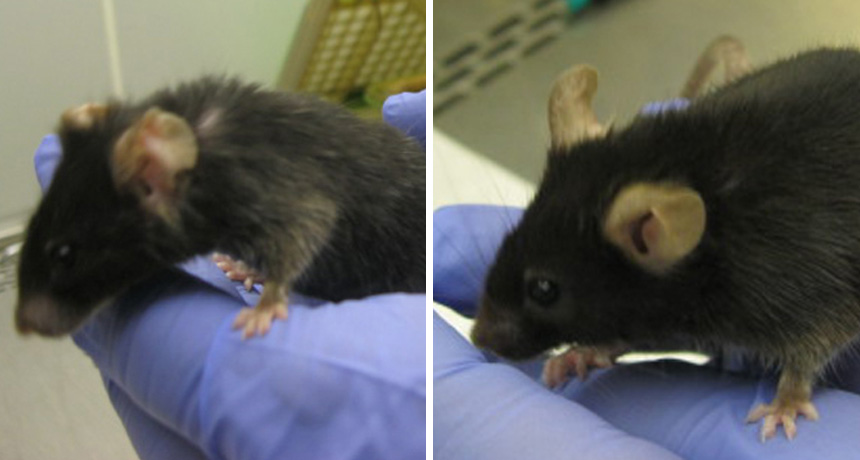Donor mitochondria could influence metabolism, aging

For a “three-parent baby,” getting disease-free mitochondrial DNA from a surrogate may do more than just avert disease: For better or for worse, a donor’s mitochondria could also affect the course of aging, new research shows.
Two strains of mice – genetically identical except for the source of their mitochondria, the energy centers of cells – aged very differently, researchers report online July 6 in Nature. Even though both mouse strains had healthy mitochondrial DNA, the mice with mitochondria that did not come from the same source as the rest of their DNA fared better later in life: After two years, these mice showed fewer signs of aging and had a lower incidence of tumors.
The results don’t necessarily mean that a mitochondria transplant leads to a healthier life. This is just one case, researchers caution. Other DNA mixes and matches could turn out differently. But the study’s finding does point to a larger relationship between mitochondrial DNA and aging and raises new questions about the long-term effects of creating three-parent babies.
What the new results mean for people is still unclear, says Michio Hirano, a neurologist at Columbia University who was not involved in the study. But if the findings do apply to humans, he says, “you can blame your mother for how you age.”
Mitochondrial DNA is passed down from mother to child. Three-parent babies are created through an in-vitro fertilization technique that substitutes a mother’s diseased mitochondria for the healthy mitochondria of a surrogate (SN: 11/17/12, p. 5). In the procedure, which is legal in the United Kingdom and deemed ethical by a U.S. panel of experts this year (SN Online: 2/3/16), a baby inherits its nuclear DNA — the majority of its genetic fingerprint — from mom and dad. But a small amount of DNA — just 37 genes — comes from the mitochondria of a second, healthy woman.
Mitochondria do more than just power cells; they also play big roles in cell-to-cell communication and metabolism. Over the last two decades, mitochondria have also been implicated in aging but without conclusive evidence. The new research, Hirano says, “adds fuel to this debate.”
In the study, José Enríquez of the Spanish National Center for Cardiovascular Research in Madrid and colleagues bred two strains of mice. The original strain was called C57/Black 6. A second strain of C57/Black 6 carried mitochondria from another kind of mouse called NZB. This mismatch mimicked the effects of a mitochondrial transplant. Early in life, normal C57 mice bulked up faster than those carrying NZB mitochondria and had 11 percent longer telomeres (protective caps at the ends of chromosomes that get shorter over time, so are used as a proxy for aging). But later in life, the mice with NZB mitochondria had longer telomeres, less fat in their muscles and lower risk of having liver tumors at the end of their lives.
Young C57 mice “tend to be stronger,” Enríquez says, probably because their mitochondrial and nuclear DNA are a good match and make efficient mitochondria. The weaker batteries in the mice with mismatched mitochondria may cause more cellular stress early on, he says, which may toughen up these mice to age more gracefully.
Since the study was done in mice, researchers don’t know how mitochondrial substitution would affect aging in humans. To avoid unforeseen and unwanted consequences, Enríquez urges caution. “Before we understand it better,” a mitochondrial transplant should mimic natural conditions, he says: “Why don’t we match the mitochondrial DNA of the donor and receptor?”